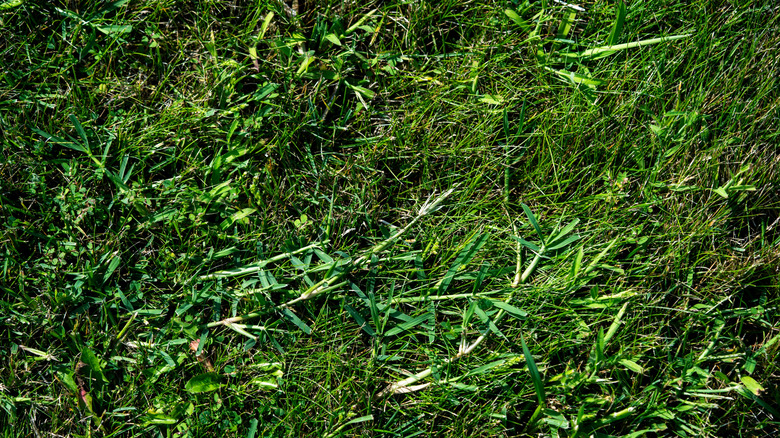The Powerful Solution That Will Blast Crabgrass And Clover Out Of Your Lawn
We may receive a commission on purchases made from links.
Battling with various types of weeds in your lawn often requires pulling them up or conducting a precise attack with a bottle of weed killer. If you're mainly plagued with clover and crabgrass, your best weapon is an herbicide to blast them out of your lawn. One option recommended by lawn experts is Tenacity, which kills nearly 50 broadleaf weed and grass species, including both Southern and large crabgrass as well as clover. As the name promises, it offers targeted applications for these stubborn weeds. Most users see results as the weeds in two to three weeks. It works for both pre- and post-emergence, so it can be a versatile solution for weed management.
Tenacity's strength and effectiveness features an active ingredient called mesotrione. Mesotrione is a synthetic herbicide inspired by a natural allelochemical, leptospermone, that is found in the Californian bottlebrush plant (Callistemon citrinus). This allelochemical can disrupt growth in nearby plants, and a scientist from the agricultural company, Sygenta, synthesized it to form mesotrione. The mesotrione in Tenacity is used to inhibit chlorophyll production and photosynthesis in other plant species. After application, the weeds absorb the mesotrione through their leaves and roots, stopping their growth and starving them. The stunted growth eventually causes bleaching and then death. It's approved for use in all 50 states as well as the District of Columbia, letting homeowners nationwide tackle these persistent weeds. Here's how to use it on your own lawn.
Using Tenacity to kill clover and crabgrass
This is not the most beginner-friendly herbicide, unlike other pre-mixed options, and it's costlier than other brands. It requires precise mixing and application. If you treat the same area twice, it may lead to grass burning and discoloration. Lawn care experts advise adding food coloring or a temporary coloring agent so you can easily spot previously-treated areas during application. For pre-emergence control, you'll combine 4 to 8 fluid ounces per acre of land with 30 gallons of water, then shake well until it fully mixes. Apply using a sprayer to ensure full, even coverage, but use caution with certain grass types. If treating perennial ryegrass or fescue grasses, as well as mixes with 50% of either species, you must not exceed 5 fluid ounces per acre. For St. Augustine grass sod, you mustn't go over 4 fluid ounces per acre. For extended control of annual crabgrass, Syngenta recommends mixing in a preemergence herbicide such as Barricade 65WG Herbicide.
According to the manufacturing label, you can apply Tenacity while seeding cool-season grass, making it ideal for a new lawn or overseeding. But it's not compatible with every lawn and may even damage your turf. Avoid using Tenacity on warm-season grasses, including Bermuda grass or zoysia grass. The only approved warm-season variety is Centipedegrass and St. Augustine grass sod. Results aren't instant either, which may annoy frustrated homeowners tired of weeds. You eventually have white grass tips as the herbicide suppresses the chlorophyll. Removing them will block the herbicide from fully reaching the roots, so leave the withering weeds intact and the color will bounce back.
Is Tenacity safe to use around children, pets, and wildlife?
When spraying any weed killer in the yard, many homeowners will understandably want to know if it's safe for children, pets, and wildlife. Fortunately, unlike other weed killers, the answer is yes. Tenacity is safe to use around kids and animals when applied correctly. It's non-toxic and is rated Reduced Risk by the U.S. Department of Environmental Protection (EPA), which means it poses low harm compared to other herbicides for sale. However, Tenacity does still require users to take precautions during application for everyone's protection. Keep children and pets out of the area during the treatment process and until the product fully dries. Once fully absorbed by the plant, it's not harmful. The drying typically takes four to six hours, on average, depending on the weather.
You should exercise extra caution around pollinators. Tenacity has the potential to cause adverse effects in bees and other pollinating insects. You can mitigate this risk if you avoid spraying in areas with frequent pollinator activity, such as around flowering shrubs or plants. You should also apply in the early hours and evening, as these are times when bees aren't actively foraging. Runoff is another concern for Tenacity, so you should avoid application if rainfall or irrigation is expected within 48 hours.


